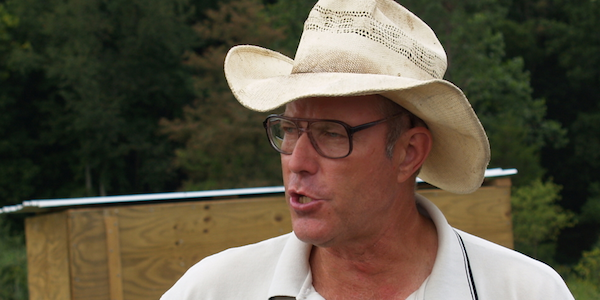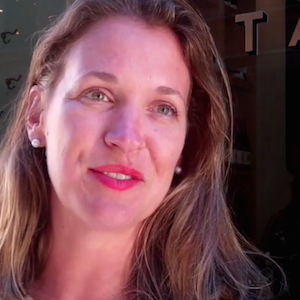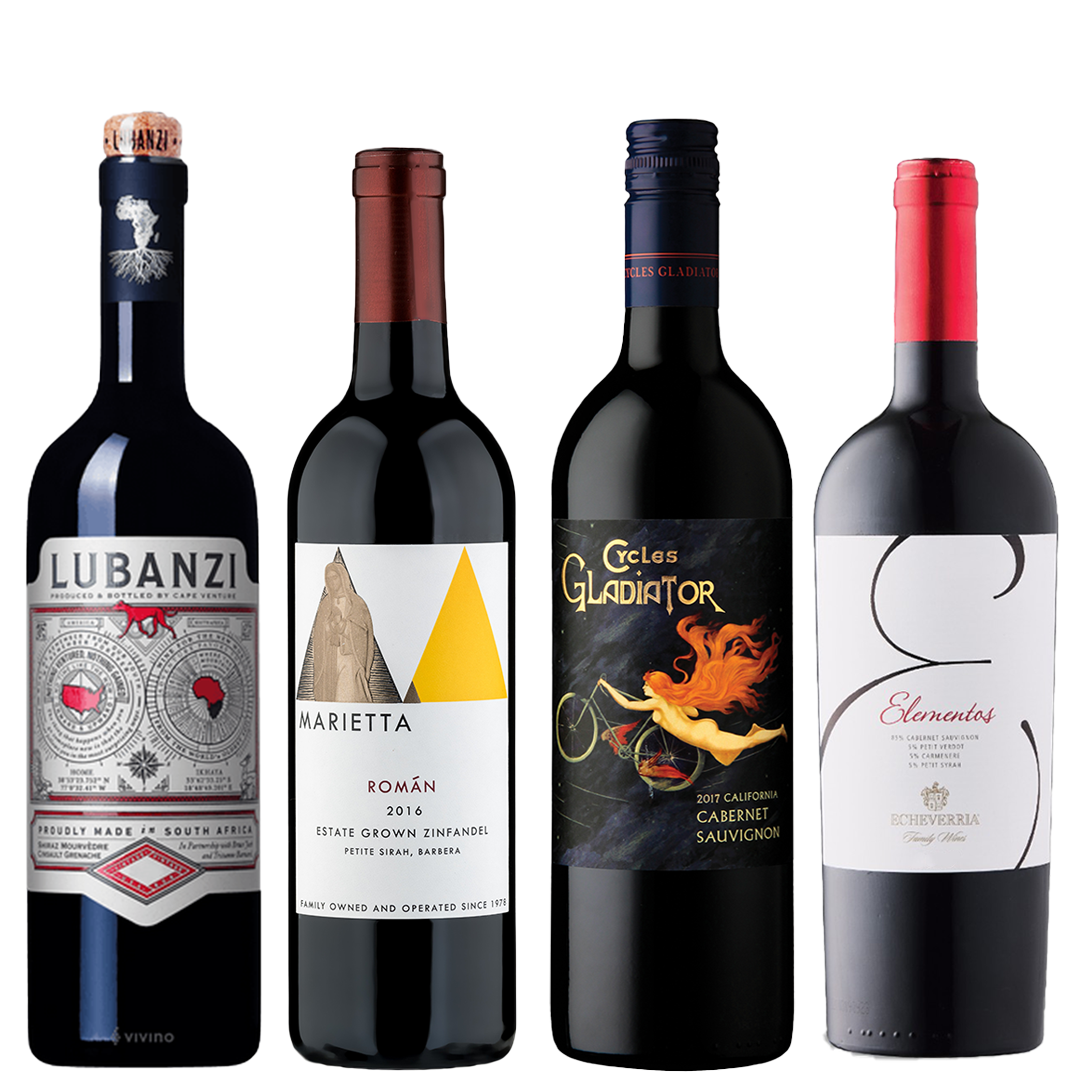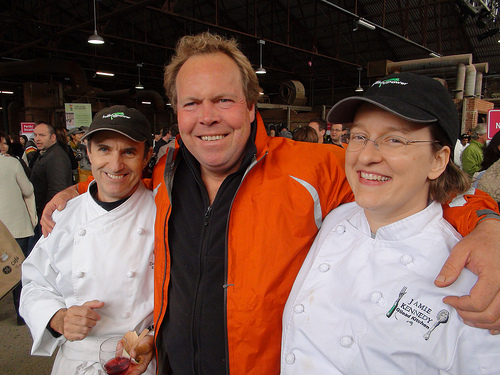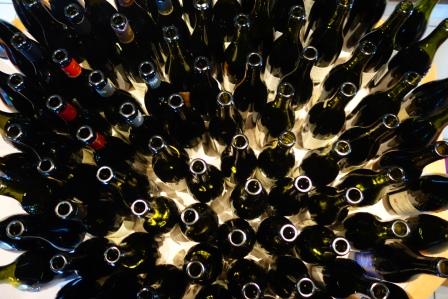by Malcolm Jolley
Joel Salatin has described himself as a ‘Christian-libertarian-environmentalist-capitalist-lunatic-farmer’. The Virginian and his family’s chicken farm, Polyface (The Farm of Many Faces) came to prominence as one of Michael Pollan’s subjects in The Omnivore’s Dilemma and is considered one of North America’s more avant-garde practicioners and evangelizers of ‘holistic’, organic farmers.
Salatin came to Toronto in November to promote his new book Folks This Ain’t Normal and I met him at a downtown café to ask him about the book, how he integrates modern technology into traditional farming and what we can do to change the way food is grown and consumed.
The Interview…
Good Food Revolution: You’re in Toronto to promote your book, Folks This Ain’t Normal, which tracks your journey as a farmer. What isn’t normal?
Joel Salatin: What isn’t normal?!? Oh my, so many different things. One is that we’re the first civilization in history (and I’m lumping Canadians and Americans together) that routinely eats “foods” that you can’t pronounce, foods that you can’t make in your kitchen, food that travels 1,500 miles between field and fork, food that’s wrapped in layers of cellophane plastic with bar codes on it, food that’s not kept in a home larder but offsite in some corporate warehouse somewhere, food that’s grown with chemical fertilizers, food that’s grown as single species on farms (as opposed to multi-species who have complex relationships between them)… all of this plus energy. The book is not just about food. It’s a cultural thing that we’re the first civilization that’s ever had cheap energy, which allows us to consider economies of scale without understanding them. And the book ends a few chapters on ‘The Food Police’ and the food choice issue and how we’re the first civilization that has deemed it perfectly safe to feed your kids Mountain Dew, Twinkies and Cocoa Puffs, but not raw milk, compost-grown tomatoes and Aunt Mathilda’s homemade pickles – those are dangerous substances. In the continuum of human history, these are all complete anomalies. So the point of the book is we, as a modern, developed, techno-glitzy culture, might be the first civilization that thinks we can abdicate a visceral understanding of our ecological umbilical chord and survive. But I don’t believe we can, because we are biological beings. We are fundamentally nested in an ecology of soil, air, water: a food web. And we’re not going to wake up tomorrow and start popping Star Trek nutrition pills.
GFR: From what I understand, the further we get from that ecological food model, the worse off we are. We get these industrial diseases like diabetes, cancers and whatever else?
JS: Absolutely. There’s a real sense among many of us now that we are at a precarious place. Now, who knows what the tipping point is? Maybe we’ve already reached it – I hope we haven’t reached it yet. But when you look at the precarious precipice of a lot things, whether it’s food recalls because of pathogens, nutrient deficiency , soil loss, water loss, chronic illness, obesity, these are all part of that “developed” culture. There’s a sense among many of us that we simply can’t sustainably regenerate with our current models.
GFR: OK, but you are a farmer and the way that you farm is, actually, pretty high-tech. So, you’re not advocating going back a few hundred years to an ox and plow, right?
JS: No, not at all! I love my four-wheel-drive tractor and my front-end loader and all that sort of thing. But, but, but that doesn’t mean that we don’t farm looking for those niches that plants and animals filled before. I’ll give you an example. Let’s take chickens. Everybody likes chickens. They’re a real easy animal, and everybody has a chicken story. Well, historically chickens were essentially a “salvage recycler”. That’s why they were always next to a kitchen, right out behind the farm house. Blemished fruit, peelings, spoilage – that sort of thing – always went to feed the chickens. And you didn’t have municipal composting operations. You didn’t have landfills because this biodegradable material, this decomposing biomass all got converted into eggs or meat that we could, then, eat. Well, today we have compartmentalized and segregated ourselves to where we actually think we’re being really green if we separate our compostables and put them on a diesel truck to go a plant somewhere so we can buy back little plastic baggies for compost to put around our nasturtiums.
What I’m suggesting is that part of the historical glue that held the food security of a community together was embeddedness. It’s where we actually actually embed and integrate food in a community: the butcher, the baker, the candle stick maker. We’re not in box stores outside the residential areas – they actually lived above their craft stores – it was integrated.
GFR: And you knew who they were, so if they sold you something that was off you could come back and complain to them personally.
JS: Absolutely. The guy who wasn’t good: everybody knew it and word would travel fast. He got vetted – his transparency is what vetted him. It was inherent. So, we could, for example, embed chickens next to kitchens. Two chickens in a condominium don’t take up any more room than a parakeet or a dog. A dog will eat and make more manure than two chickens. I’m just talking about two chickens who would eat your kitchen scraps and give you eggs. Now, you don’t have to have an industrial egg commerce. Now, eggs are produced on site as part of a recycling program.
GFR: Wait a minute! Then, aren’t you out of business? You’re a chicken farmer!
JS: [Laughs.] Oh, listen: I would love to think that everybody is going to buy this book and adopt these procedures, but I’m not naive enough to think this is going to happen. The fact is, I’m far more concerned at historical normalcy than I am in continuing exactly the way we farm because, in a lot of ways, I see our own egg production, which depends a lot on grain, as being abnormal. This is a vulnerable thing, and I’m the first to admit that.
GFR: You’ve been farming for 50 years. What have you changed in your operation? What have you learned?
JS: The main thing that’s changed in our operation is the high-tech infrastructure. We used to carry cloths to polish the heads of very fickle electric fence energizers that used the points out of a car distributor. Now we don’t even have distributor caps because modern cars don’t have spark plugs. And now at the farm we have things like ultraviolet stabilized shade cloth for very portable structures. We have bandsaw mills that allow us to efficiently take a log – for example, a small log – and lathe it off into small little tinker toy pieces that we can use high tech engineering to build lightweight truss-type potable structures that 50 years ago wouldn’t have been impossible. We have conductive copper and malleable aluminum-alloy filaments that can take electricity through polyethylene webs so we can have netting that keeps chickens and turkeys in an area and 150 feet of it is only 12 pounds so one person can take it up and put it out in 10 minutes and it keeps out bears, coyotes and foxes! I mean, this is really an “aha thing” here!
We really have an exciting time to be alive and the point is we’re using this technology to improve the habitat see how we can enhance the chickeness of the chicken. Rather than what industry does, which is to see how to use our creativity to make hotter antibiotics to kill the pathogens that come when you confine 50,000 chickens on a concrete slab with no sunlight and electric energy intensive fans to try to move the fecal particulates around. A chicken is a bird. A bird likes to have fresh air, sunshine, to run around outside. So, my point is that it’s far more secure and normal to use our creativity and innovation to enhance that chickeness of the chicken’s life, and in doing so, guess what? We have much higher quality eggs. For example, we just had our eggs checked and the USDA labels for eggs says that each egg contains 37 micrograms of folic acid but ours have 1,037. It doesn’t even compare. When you consider that food is the ultimate pharmaceutical, in other words, that food should be our first line of defense in health care, you realize that connection when you start to look at the nutrient profiles of the foods that come out of these kinds of systems.
GFR: Speaking of what people eat, one of your points is that it’s no good for you to be raising these amazing chickens if no one knows how to cook them.
JS: Yes! In the book I make a big point of saying that one of the single most important things that you and I can do as an individual consumer is to get into our kitchens. We need to rediscover what I call the jazziness of the domestic culinary arts. You know, we are a culture that has never spent more money remodeling and gadgetizing our kitchens. Talk about technology: slow cookers, Cuisinarts, bread makers, ice cream makers and all these cool things we have, and yet most people don’t know how to use them. So, this is not about being barefoot, pregnant in the kitchen with a hoop skirt catching fire in the fireplace. This is about taking normal, unprocessed, unwrapped, unpackaged, uncellophaned foods and processing and preparing them in our own nests again so that we reattach our responsibilities and our historic visceral understanding of what’s going to become flesh of our flesh and bone of our bone. We live in a culture where, unfortunately, the average person is much more passionate about learning who got their belly button pierced today in Hollywood than what’s going to become flesh of my flesh and bone of my bone at six o’clock. Folks, this ain’t normal!
GFR: That ain’t normal. Good Food Revolution is by and for people who really do love good food and we know that if you’re in the kitchen and cracking the egg and see the colour of the yolk, you’re going to start looking for better eggs and better butter and better bread…
JS: Yup. If all you ever have is Egg Beaters, you’ll never get the nuances of the relationship between yolk colour and taste. Or how an egg stands up or flattens out relative to taste and quality. And so, we as a culture have abdicated this historical role that our sensuality, our senses, are supposed to be communicating to us. I don’t want to sound too mystical or weird but it’s important to know what garlic smells like when it’s cooking, or what eggs look like when they’re cracked out of a shell.
GFR: Let’s talk a little bit about economics and marketing, because you’ve been quite successful at creating demand for your supplies. Are you sold out every week?
JS: Well, in the fall we’re always sold out of eggs. But we could produce a lot more. We still need to cultivate the market. It’s amazing, still, how many people go to McDonald’s. I guess, my thing is we’ll know we’ve hit a benchmark of success when we start seeing if some of the fast food chains can’t make money any more because people aren’t going there. There’s still lots of room for change.
GFR: OK, so what can the average consumer do other than keep a chicken near their kitchen?
JS: In the book I make the point that you shouldn’t feel like you’re insignificant. We are where we are because what we have represents the cumulative effect of lots of individual decisions. For example, if everyone drank soft drinks as often as I did, they wouldn’t exist. I am not saying it’s sinful to drink a soft drink, I’m just saying that if I look at the world that I patronize, it’s a fundamentally different world than we see out here. So, first of all the average person should take some of their recreational, entertainment, informational time and realize that the kitchen is a great focal point for life. Our kids learned their fractions cooking – what’s a half of a third of a tablespoon? So you learn math, and then you learn chemistry. How do you bind things?
GFR: Alice Waters, who founded the Edible Schoolyard, came under attack in the past year from a magazine columnist who said it was ridiculous for kids to be digging a garden instead of learning math, so you don’t buy that?
JS: No! I see it as the most fundamental classroom in the world. To know how to grow something, how to cook something – this is true math. You’ve got so many feet of row, or you’ve got four square feet in a backyard pit and we’re going to plant beets in two inch centres: how many beets can we plant? It’s called associated learning, as opposed to disassociated learning. So get in your kitchen. Buy unprocessed foods. Grow something yourself. It could be a patio on a condominium. Or ask your landlord if you can have ten feet by ten feet plot to grow something. Or farm the edges: there’s a fascinating book coming out called Food in the City. It talks about people who go out in front of their houses and take that little four foot strip between the sidewalk and the street and just start growing vegetables in there. Edible landscapes: we’ve got tons of spots! Even here in Toronto: as I drove over this morning I saw a lot green and I thought instead of growing ornamentals we could grow edibles. And then, we could just sit here with a sense of abundance! Wouldn’t that be great? As the economy goes to pot and we’re worried about everything, we could at least look around and see apples and grapes – that’s such a secure thing.
GFR: But we still need farms, surely?
JS: Yes. One of the things I ask [in Folks This Ain’t Normal], is that people take some of their entertainment-recreational budget (both time and money) and go visit your farm treasures. Every single area has its farm treasures. Not only just farmers markets but I mean go visit a farm. It’s still a subculture – it amazes me how many people have never been to a farmers market. When you say “CSA” most people think you mean Confederate States of America! Or they can’t even conceive of, for example, buying half a hog. Well, cancel the Bambi-Disneyfied vacation and instead go visit the farm treasures in your area. What happens is that as you start down this path your understanding and your skill level will increase. It’s just like any skill. You know, we all grow up hearing ‘if it’s worth doing, it’s worth doing right’, but in truth if it’s worth doing, it’s worth doing poorly first. Nobody walks well first, nobody writes well first and nobody cooks well first. So, I want to liberate people from that stigma and get them cooking in the kitchen from their larder.
GFR: There’s growing audience for our website who are second career farmers, what advice do you have for them?
JS: My advice to anyone who wants to join in on farming is diversify. Nature is diversified, and I know you’ll always have a core thing that you’ll really like, but hang stuff around the edges of it. It will make your place more interesting for people to come to, and it’s a lot easier to sell something else to an existing customer – always listen to your customers. And the final thing I would say is just stay with it. We haven’t got to where we are in a day, and we won’t get to where we want to in a day. When I’d get discouraged, my dad always used to say, “If at first you don’t succeed, then suck and suck and suck until you do suck-a-seed.”
Photo above: courtesy Arlene Stein.
 Malcolm Jolley is a founding editor of Good Food Revolution and Executive Director of Good Food Media, the non-profit organization that publishes GFR. Follow him at twitter.com/malcolmjolley. Photo: John Gundy.
Malcolm Jolley is a founding editor of Good Food Revolution and Executive Director of Good Food Media, the non-profit organization that publishes GFR. Follow him at twitter.com/malcolmjolley. Photo: John Gundy.

